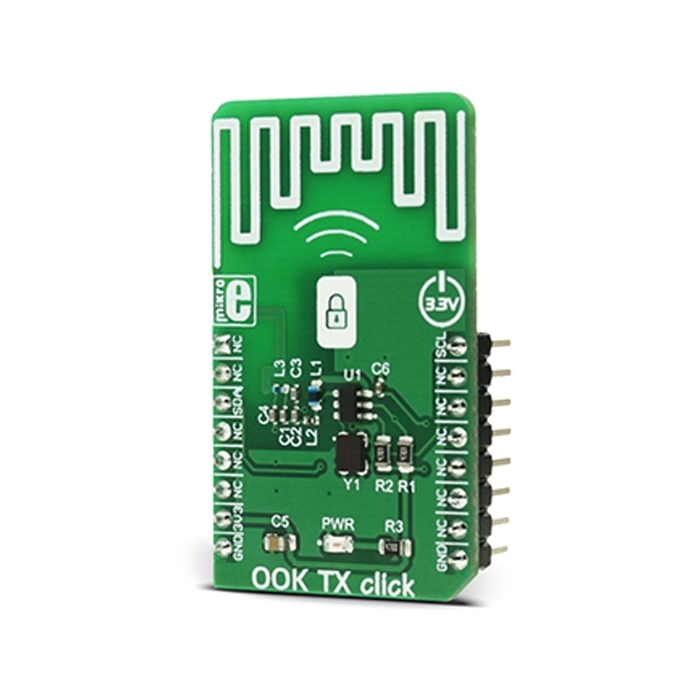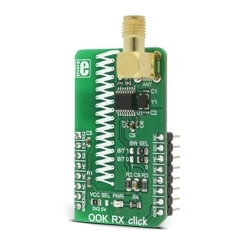MIKROE OOK TX Click
OOK TX Click is a simple wireless transmitter that operates at the frequency of 433MHz (sub-GHz).
Product Overview
OOK TX Click is a simple wireless transmitter that operates at the frequency of 433MHz (sub-GHz). This device allows realization of a simple, low-speed wireless ad-hoc communication network between a transmitter and compatible receiver, such as the OOK RX Click. This device features a programmable transmit power in 1dB steps, On-Off Keying (OOK) modulation with power ramp-up control, and it complies with US (FCC) and Canada (IC) standards.
This kind of networking is widely used for remote low-speed communication, such as the remote keyless access, remote fan or light control, garage or gate doors control, unidirectional low data rate wireless links and similar applications where this kind of communication is applicable.
The OOK TX Click uses the MICRF114 IC, a 285MHz to 445MHz low power integrated RF transmitter, from Microchip. The working principle of this device is based on the encoding of information and embedding it in a radio signal. The OOK modulation is a way to encode information and assemble it into radio signals which can be transmitted and received wirelessly.
Generally, the OOK modulation is a subtype of the ASK modulation, but it is of a binary type. OOK is an abbreviate for the Off-On Keying, which perfectly describes this type of modulation. The presence of the carrier signal is recognized as the logical 1, while the absence of a carrier signal is recognized as the logical 0. This method is more immune to noise and interferences than the ASK modulation, and it allows for greater communication distance to be achieved.
The transmission signal of OOK TX Click is generated by the internal synthesizer section of the MICRF114 IC, which operates at a single frequency. The external oscillator with the base frequency of 13.56 MHz is used so that the RF signal frequency is 433.95MHz, a perfect match for the OOK RX Click, which operates on the exact same frequency. The MICRF114 IC has a single RF output pin, which can be easily matched with the onboard single pole PCB trace antenna.
The communication with the MICRF114 IC is done through the 2-Wire (I2C) interface. The communication is unidirectional - from the MCU to the MICRF114. The transmission parameters are kept within one 16bit register, so the configuration is simple and easy. On a power-on reset event (POR), the device is loaded with the default values and it is necessary to initialize it, before starting the transmission. The device features auto calibration, which is engaged after each POR, although the MCU can request the recalibration. The recalibration is required if the operating frequency is changed, so it is usually not requested on the fly.
There are two modes of operation: Sleep mode and Transmit mode. The MCU initializes the communication by sending the Start signal over the communication bus. The Start signal is followed by the mandatory Control bits and optional Configuration bits. After the rising edge of the last bus clock pulse on the SCK pin of the MICRF114 IC, the wake-up sequence will start and the device goes into Transmit mode. The MCU should keep the clock line at a LOW state and after waiting for the maximum wake-up time interval, the transmission can start. At this moment, the communication becomes asynchronous and the device directly modulates the carrier signal with the data incoming on the SDI pin. After receiving the Stop signal on the bus, the transmission is ended and the device reverts to the Sleep mode. While in Sleep mode, most of the sections are powered down and the power consumption is minimal. The SCK pin of the MICRF114 IC is routed to the mikroBUS™ SCL pin, while the SDI pin of the MICRF114 IC is routed to the mikroBUS™ SDA pin.
The included MikroElektronika libraries contain all the functions needed for an easy and proper configuration of the transmit parameters and communication itself. The included demo application can be used as a reference for a future design.
Although OOK TX Click features a programmable output power, the small PCB trace antenna limits the transmitted signal power, so it can stay within the European Telecommunications Standards Institute (ETSI) limitations. The device complies with the FCC and IC regulations. For this reason, an external SMA connector is not used.
OOK TX Click comes equipped with the pull-up resistors on its 2-Wire (I2C) communication lines. It is meant to be powered only from the 3.3V rail of the mikroBUS™
Features & Specs
- Interface: I2C
- Compatibility: mikroBUS™
- Dimensions: 42.9 x 25.4mm
- Input Voltage: 3.3V
- Output Power: Min. -2 dBm, Max. +13 dBm
- POR Delay Time: 20 ms
- Wake-up Time: 3 ms
- Calibration Time: 2 ms
Documentation
Customer Reviews



